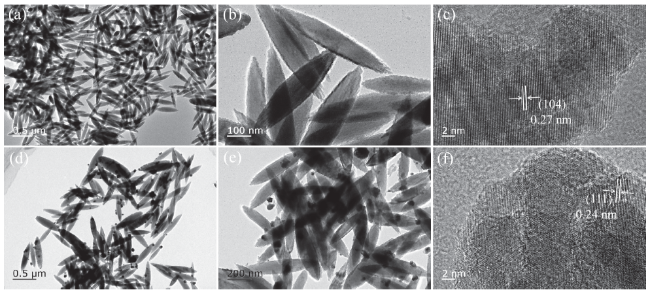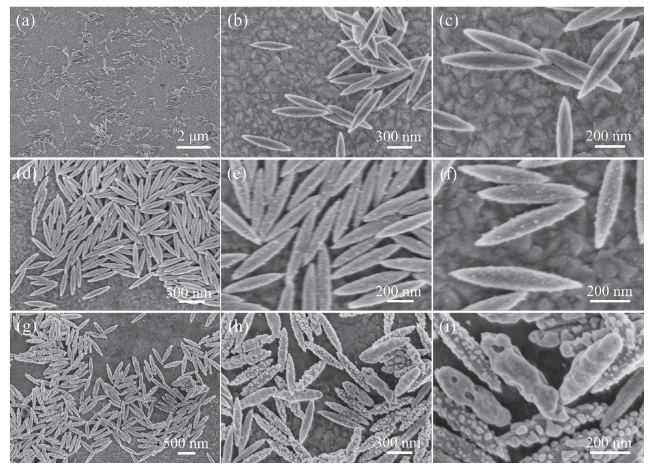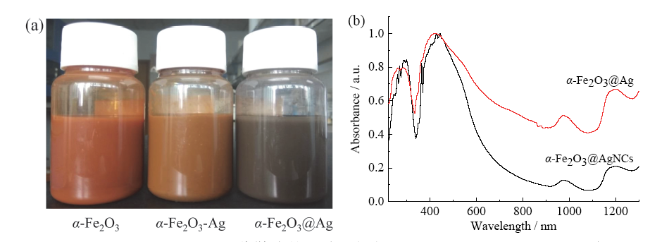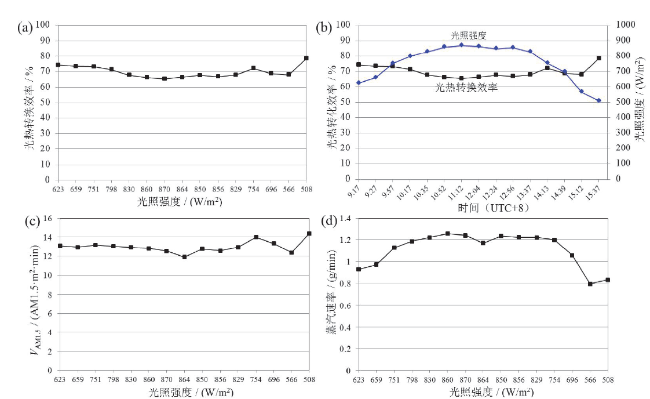0 引言
1 实验部分
1.1 实验试剂和装置
1.2 表征设备
1.3 制备方法
2 结果与讨论
2.1 α-Fe2O3纳米米粒的稳定性、耐酸碱性和耐还原性
Fig. 1 SEM images of α-Fe2O3 nanorice: (a,b) freshly prepared solution; (c,d) long-term stored (more than 16 months) solution图1 α-Fe2O3纳米米粒的SEM图:(a、b)新制的α-Fe2O3纳米米粒;(c、d)贮存超过16个月后的α-Fe2O3纳米米粒 |
Fig. 2 SEM images of α-Fe2O3 nanorice before (a-c) and after (d-f) acid and alkali resistance, temperature resistance and reduction resistance experiment图2 α-Fe2O3纳米米粒的耐酸碱、耐温性和耐还原性实验前后的SEM图:(a ~ c)反应前;(d ~ f)反应后 |
2.2 多极子共振吸收的结构和形貌特性
Fig. 3 TEM and HRTEM images of α-Fe2O3 (a-c) and α-Fe2O3-Ag (d-f)图3 α-Fe2O3纳米米粒(a ~ c)和α-Fe2O3-Ag(d ~ f)的TEM和高分辨TEM(HRTEM)图像 |
Fig. 4 SEM images of α-Fe2O3 nanorice (a-c), α-Fe2O3-Ag (d-f) and α-Fe2O3@Ag (g-i)图4 α-Fe2O3纳米米粒(a ~ c)、α-Fe2O3-Ag(d ~ f)和α-Fe2O3@Ag(g ~ i)的SEM图像 |
Fig. 5 (a) Photograph of α-Fe2O3, α-Fe2O3-Ag, and α-Fe2O3@Ag dispersions; (b) UV-vis-NIR absorbance spectra of α-Fe2O3-Ag and α-Fe2O3(core)@Ag(shell) range from 220 to 1 300 nm图5 (a)α-Fe2O3、α-Fe2O3-Ag和α-Fe2O3@Ag分散液的照片;(b)α-Fe2O3-Ag和α-Fe2O3@Ag在220 ~ 1 300 nm的紫外-可见-近红外吸收光谱 |
2.3 多极子共振吸收体的光吸收特性
2.4 多极子共振吸收体的综合光热转换性能
Fig. 6 The overall performances of solar steam driven by photoabsorbers with multiple plasmonic resonance peaks (multiple-peaks photoabsorber): (a) ηce under different sunlight intensity in outdoor tests; (b) ηce and sunlight intensity correspond to the local time, the curve illustrate that the sort of multiple-peaks photoabsorber deliver excellent ηc in full daytime (09:17 am to 15:37 pm), the daytime average photothemal efficiency (ηc) is above 65%; (c,d) the curves of VAM1.5 and Va along with sunlight intensity in outdoor tests (RH ≥ 55%, temperature is in the rage of 18-25oC, the harvesting irradiation area is 35 cm × 35 cm)图6 多极子共振吸收体进行光热转化产生光热蒸汽的综合性能:(a)室外光热转化实验,不同太阳光光照强度下的光热转化效率ηce;(b)不同时间下的ηce和太阳光光照强度,曲线变化趋势表明多极子吸收体在日间(09:17 am-15:37 pm)的光热转化效率优异,日均光热转换效率高于65%;(c、d)室外光照实验VAM1.5 和 Va 随太阳光光照强度的变化曲线(RH ≥ 55%,温度为18 ~ 29℃,收集的光照区域为35 cm × 35 cm) |
2.5 多极子共振吸收体的光热转换特性
Fig. 7 (a) The temperature curve in the process of generating solar steam driven by photoabsorbers with multiple plasomonic resonance peaks: include the maximum of temperature locating in liquid-air interface (black line), the average temperature (red line) and minimum temperature (blue line) of bulk liquid, respectively; the sunlight intensity is 713 ~ 703 W/m2, the high temperature of solar steam mostly range from 105 to 110oC, and the response time Tb of generating boiling vapor is 27s, the duration time of the first and the second period from onset to offset irradiation are 396 s and 447 s, respectively; (b) the capture of IR image shows the temperature distribution in the process of generating solar steam: the huge temperature gradient is more than 90oC; (c) the average temperature curve of cooling stage and its corresponding fitting curve correlates with the cooling stage had been marked with the dotted ellipse with green color in (a); (d) the curve of cooling rate result from the first order derivative calculation correspond to (c), the curve of cooling rate again the average temperature of buck dispersion can accurately calculate the instant thermal loss of convertor图7 (a)多极子共振吸收体在光照时产生高温光热蒸汽的温度曲线,包括气-液界面处的最高温度(光热蒸汽的温度,黑线)、分散液体相的平均温度(红线)和分散液体相的最低温度(蓝线),太阳光光照强度713 ~ 703 W/m2,温度曲线表明气-液界面释放的高温蒸汽温度为105 ~ 110℃,快速的光热蒸汽响应时间Tb = 27 s,第一次开始光照产生剧烈的光热蒸汽到光照结束持续396 s,第二次开始光照产生剧烈的光热蒸汽到光照结束持续447 s;(b)热红外成像,多极子吸收体产生高温光热蒸汽具有很强的局域性,高温光热蒸汽仅在辐照区的气-液界面产生,分散液体相形成很强的层温差,温度梯度大于90℃;(c)停止光照后分散液体相降温阶段的温度曲线和拟合曲线,对应(a)中绿色椭圆标记的降温曲线;(d)分散液体相降温速率与分散液体相温度的关系,降温曲线(c)一阶求导值与分散液体相温度的关系曲线即为分散液在其体相不同温度时的降温速率 |











